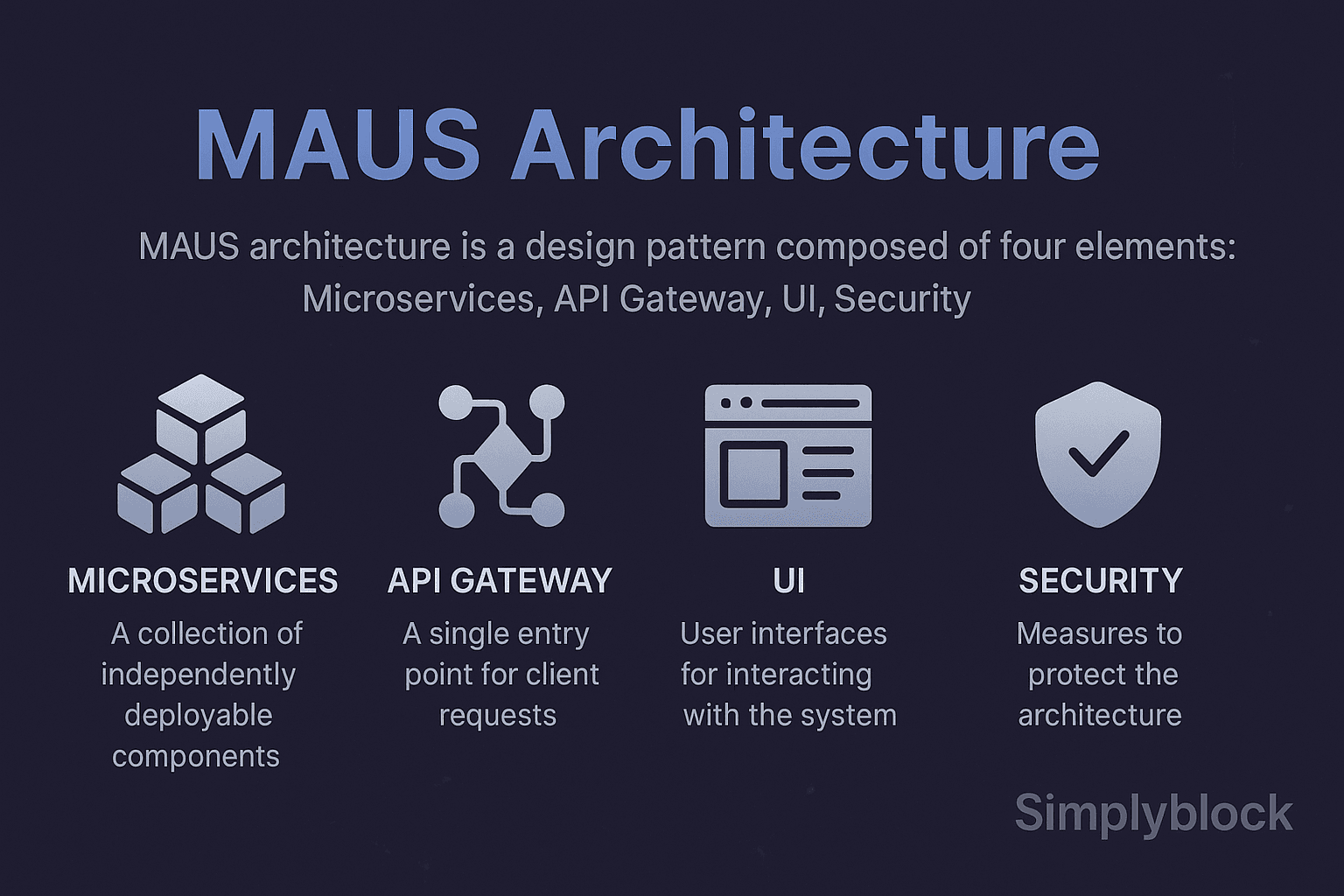MAUS Architecture
Terms related to simplyblock
MAUS architecture—short for Modular, Adaptive, Unified, Shared-everything—is a distributed storage architecture built to meet the scalability, resiliency, and performance requirements of modern enterprise workloads. It is designed to power containerized platforms, multitenant environments, and latency-sensitive services without the complexity of traditional storage systems.
Where legacy SAN or HCI stacks are rigid and siloed, MAUS enables a dynamic and unified storage layer, which is at the core of the simplyblock platform. MAUS combines four architectural principles to remove infrastructure bottlenecks and eliminate storage overprovisioning.
MAUS Architectural Pillars Explained
MAUS is built on four core principles that enable flexible, scalable, and resilient storage infrastructure. Each pillar addresses a critical aspect of modern data workloads.
Modular
Modularity enables the separation of compute and storage layers. This means storage can scale independently based on capacity or performance requirements. It’s ideal for disaggregated storage models and works well across Kubernetes, VMware, and cloud-native platforms.

Adaptive
MAUS systems adjust in real time to changes in workload behavior, node health, and application demands. Erasure coding, tiering, and replication policies are applied dynamically to ensure resilience and efficiency across the cluster.
Unified
The architecture provides one logical control plane for managing block, object, and file workloads. This simplifies provisioning, monitoring, and scaling, while ensuring that DevOps teams don’t need to juggle multiple storage systems or APIs.
Shared-Everything
Every node in the system has access to the same global namespace. Unlike shared-nothing systems, this model allows for instant failover, cluster-wide rebalancing, and consistent latency, without complex sharding logic or overhead.
MAUS Architecture vs Traditional Models
The comparison below highlights how MAUS architecture improves upon older paradigms like SAN and HCI:
| Feature | MAUS Architecture | Traditional SAN | Hyper-Converged (HCI) |
|---|---|---|---|
| Architecture Model | Modular, Shared-everything | Centralized, Controller-based | Tightly Coupled, Node-bound |
| Scalability | Scale-out, independent | Scale-up, hardware-bound | Node-coupled scale-out |
| Deployment Flexibility | On-prem, hybrid, cloud | On-prem only | Mostly on-prem |
| Multi-Tenancy & QoS | Native, with isolation | Limited | Limited, coarse-grained |
| Storage Types Supported | Block, Object, File | Block only (usually) | Block and some file |
| Control Plane | Unified | Siloed | Partially unified |
| Failure Domain Handling | Cluster-wide self-healing | Controller failover | Node-level failover |
Use Cases for MAUS Architecture
MAUS is purpose-built for environments where flexibility, performance, and operational simplicity are non-negotiable. It is especially well-suited for:
- Cloud-native databases such as PostgreSQL, Cassandra, and MongoDB require persistent block storage with high IOPS and low latency. Learn more in simplyblock for PostgreSQL.
- Kubernetes persistent volumes, where dynamic provisioning, high availability, and fast failover are essential. See best practices for Kubernetes volumes.
- AI/ML pipelines, where high-throughput shared-everything storage enables fast data ingest, model training, and parallel processing.
- Hybrid and edge deployments, where decentralized infrastructure benefits from the adaptive and unified control plane. See hybrid cloud support.
- Service providers and multi-tenant platforms, where isolating tenant workloads, enforcing QoS, and scaling elastically are required. Read more on multi-tenancy with QoS.
MAUS Architecture and Simplyblock™
Simplyblock implements the MAUS architecture to deliver cloud-native, NVMe-over-TCP storage that runs on standard Ethernet. Its shared-everything backend and unified orchestration layer allow for:
- Adaptive volume management
- Sub-millisecond latencies
- Scalable performance with minimal CPU overhead
- Support across Kubernetes, VMware, Proxmox, OpenShift, and AWS
The platform is engineered for scale-out block storage with advanced fault tolerance via erasure coding and copy-on-write snapshotting for rapid clone and backup scenarios.
External Resources
- Shared-Everything vs Shared-Nothing – CMU
- Kubernetes CSI Driver Documentation
- Disaggregated Infrastructure – Open Compute Project
- Erasure Coding – Wikipedia
Questions and Answers
MAUS stands for Microservices, API, UI, and Storage—a modular architecture pattern that separates concerns across service layers. It enables scalable, maintainable systems by isolating application logic (microservices), interfaces (APIs), user interaction (UI), and data persistence (storage), often using containerized environments.
MAUS architecture aligns with cloud-native principles by promoting loosely coupled, independently deployable components. Combined with Kubernetes-native storage, it supports dynamic scaling, fault tolerance, and high performance across services and data layers.
In MAUS, the storage layer must be scalable, secure, and fast to support independent microservices. Using software-defined storage or NVMe over TCP helps ensure each service has persistent, high-performance access to its data.
Yes, MAUS architecture enables clean separation between services and tenants. For secure data handling, encryption at rest and volume-level key isolation can be implemented on the storage side to protect tenant data in shared environments.
Unlike monolithic systems, MAUS allows independent scaling and development of each service. This reduces deployment risk, improves fault isolation, and enhances agility, especially when combined with container orchestration and cloud-native storage solutions.
